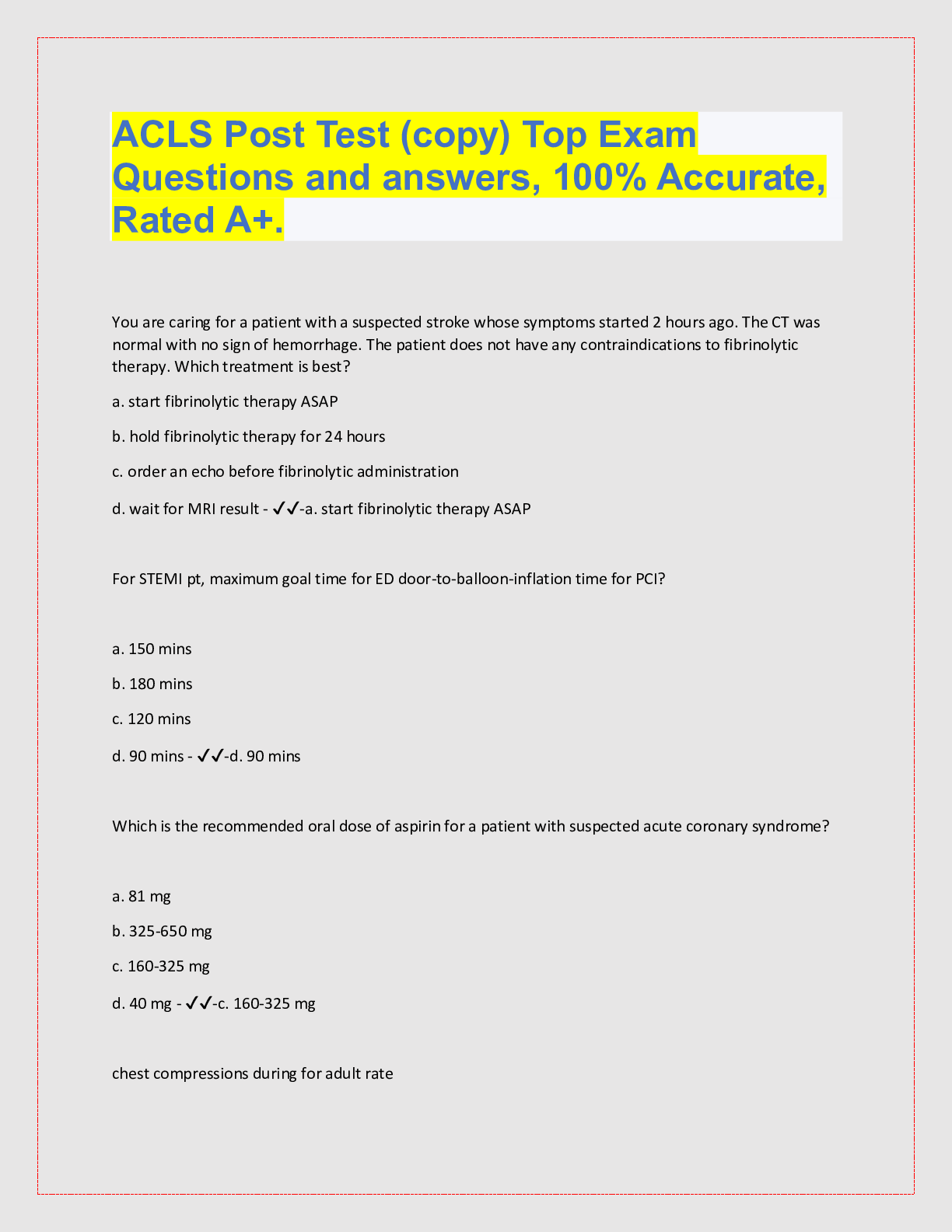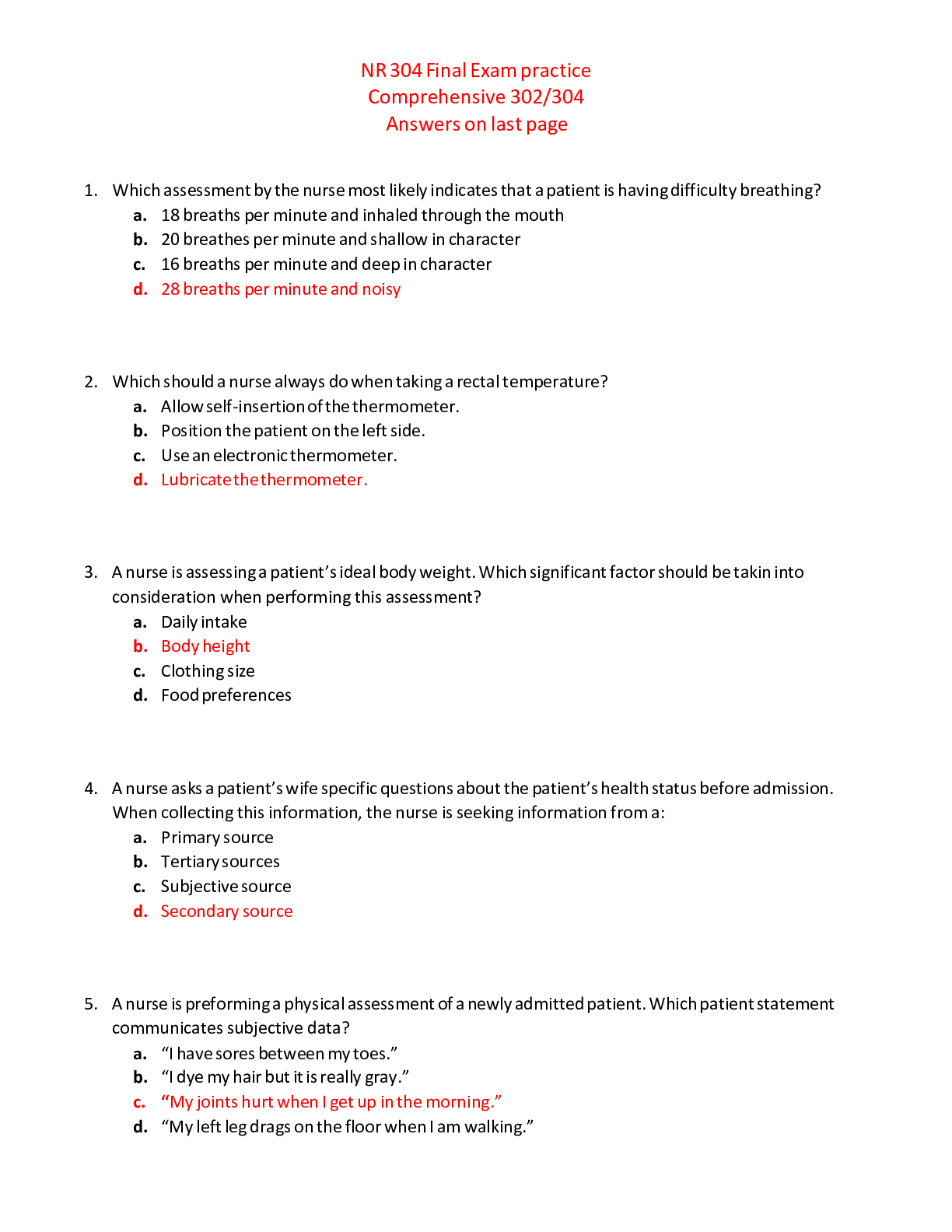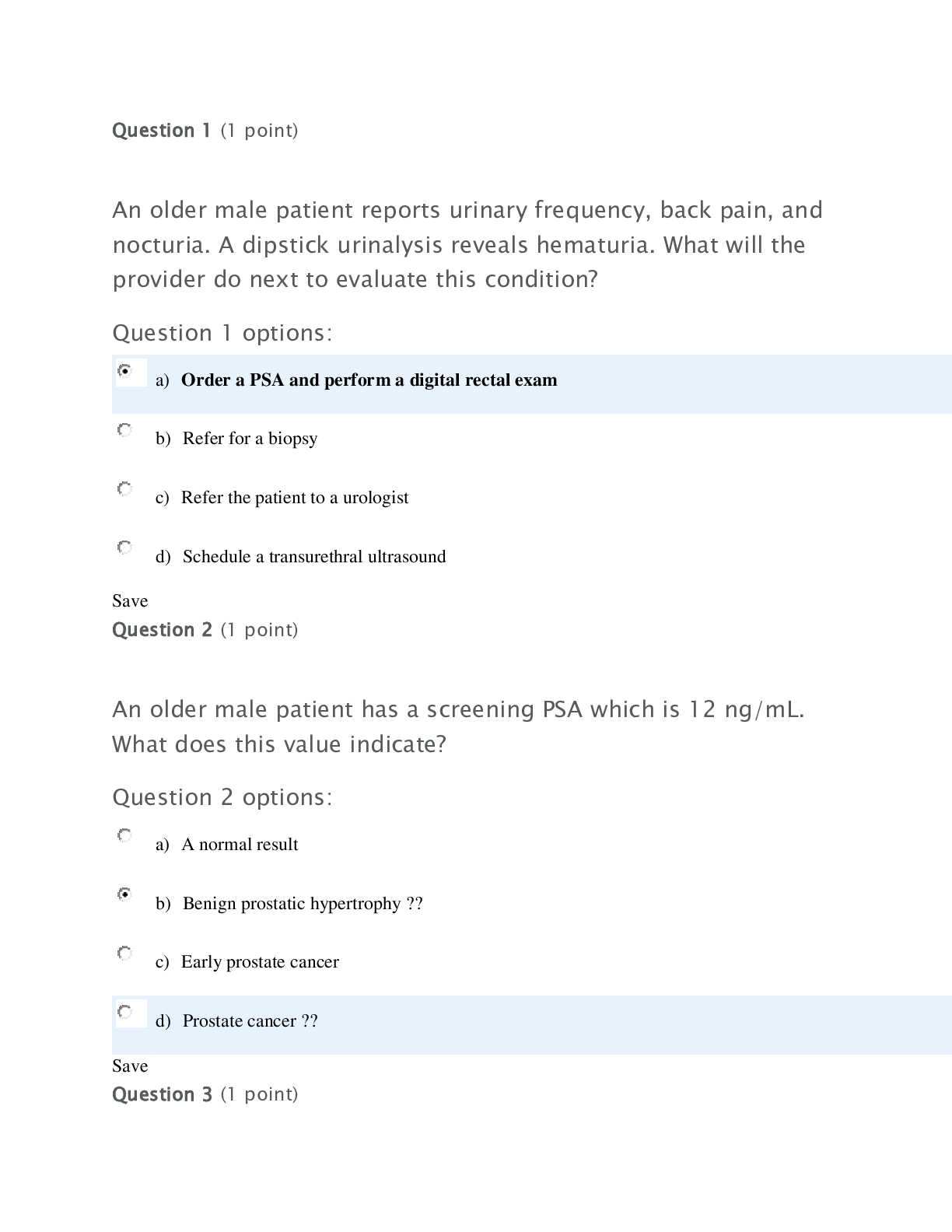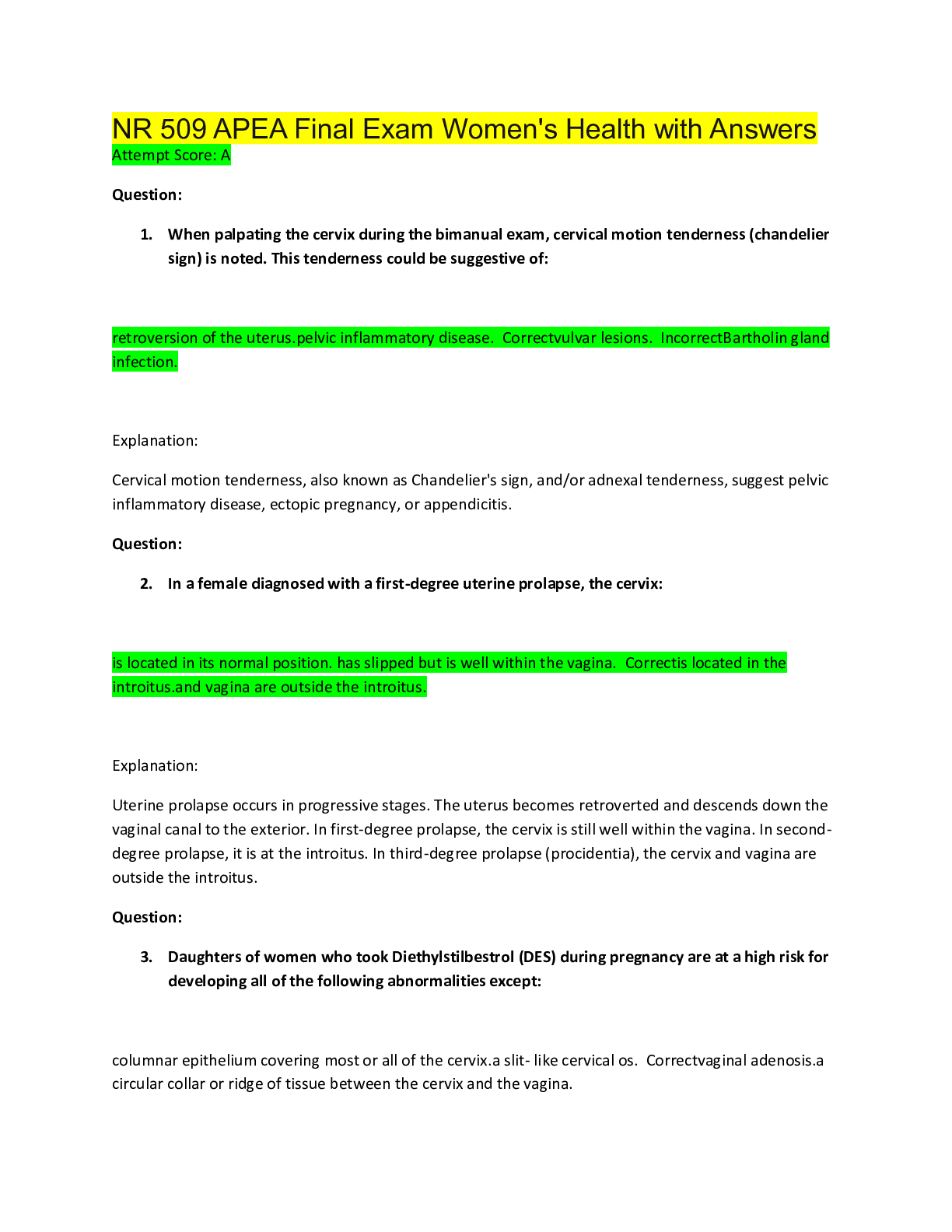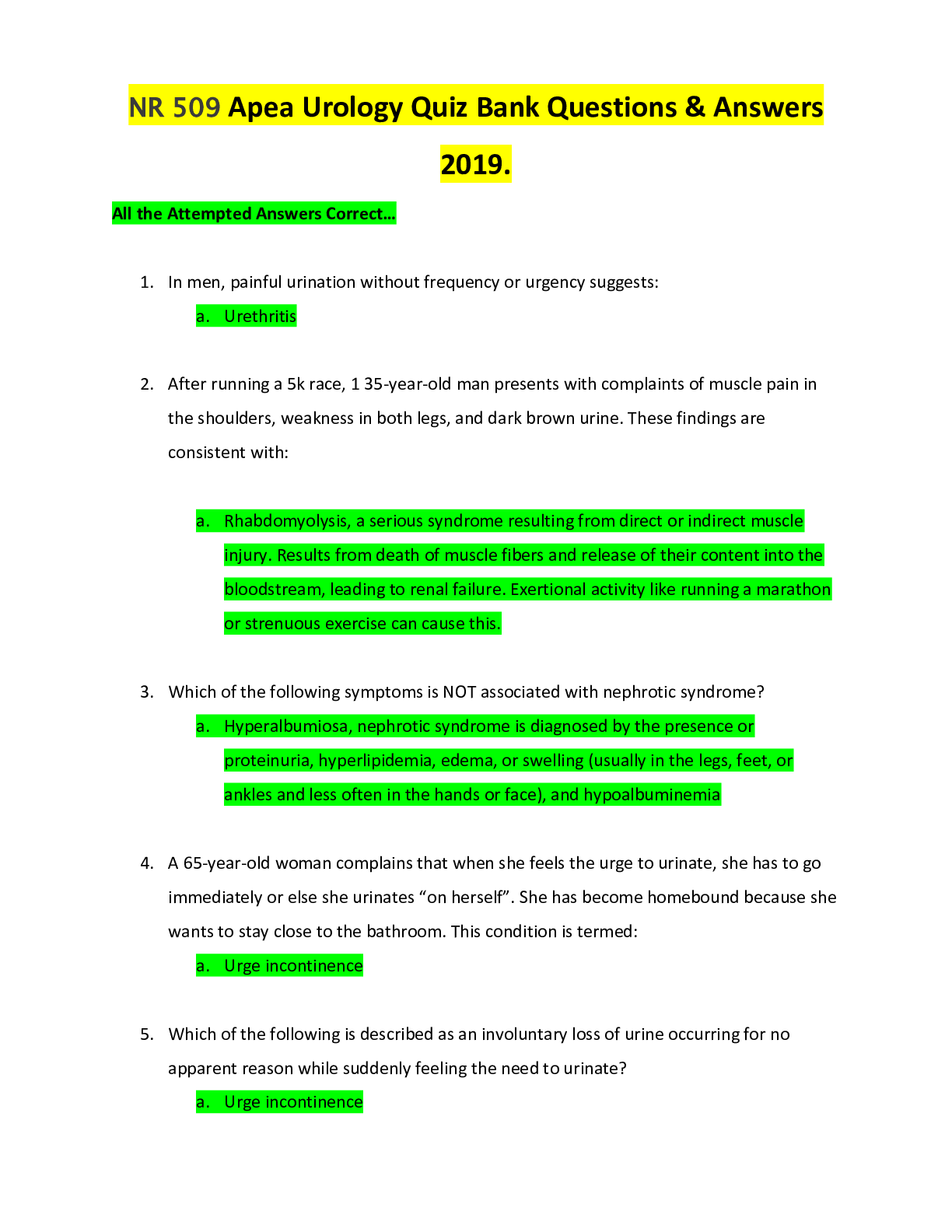*NURSING > EXAM > NR 507 Midterm Exam (Version-4) / NR507 Midterm Exam (50 Q & A, Latest-2021): Advanced Pathophysiolo (All)
NR 507 Midterm Exam (Version-4) / NR507 Midterm Exam (50 Q & A, Latest-2021): Advanced Pathophysiology: Chamberlain College of Nursing |100% Correct Answers, Download to Score A|
Document Content and Description Below
NR 507 Midterm Exam (Version-4) / NR507 Midterm Exam (50 Q & A, Latest-2021): Advanced Pathophysiology: Chamberlain College of Nursing |100% Correct Answers, Download to Score A| NR507 Week 4 Midterm... Exam / NR 507 Week 4 Midterm Exam (Latest): Advanced Pathophysiology: Chamberlain College of Nursing Chamberlain NR 507 Midterm Exam / Chamberlain NR507 Midterm Exam (Latest): Advanced Pathophysiology Question 1. Question Which substance has been shown to increase the risk of cancer when used in combination with tobacco smoking? Alcohol Steroids Antihistamines Antidepressants Question 2. Question Which term is used to describe a muscle cell showing a reduced ability to form new muscle while appearing highly disorganized? Dysplasia Hyperplasia Myoplasia Anaplasia Question 3. Question What is the final stage of the infectious process? Colonization Invasion Multiplication Spread Question 4. Question What is the most common cause of insufficient erythropoiesis in children? Folic acid deficiency Iron deficiency Hemoglobin abnormality Erythrocyte abnormality Question 5. Question Which statement is true concerning the IgM? IgM is the first antibody produced during the initial response to an antigen. IgM mediates many common allergic responses. IgM is the most abundant class of immunoglobulins. IgM is capable of crossing the human placenta. Question 6. Question Where in the respiratory tract do the majority of foreign objects aspirated by children finally lodge? Trachea Left lung Bronchus Bronchioles Question 7. Question What is the role of caretaker genes? Maintenance of genomic integrity Proliferation of cancer cells Secretion of growth factors Restoration of normal tissue structure Question 8. Question During an IgE-mediated hypersensitivity reaction, which leukocyte is activated? Neutrophils Monocytes Eosinophils T lymphocytes Question 9. Question When a patient has small, vesicular lesions that last between 10 and 20 days, which sexually transmitted infection is suspected? Genital herpes Chancroid Syphilis Chlamydia Question 10. Question What is the action of urodilatin? Urodilatin causes vasoconstriction of afferent arterioles. It causes vasodilation of the efferent arterioles. Urodilatin inhibits antidiuretic hormone secretion. It inhibits salt and water reabsorption. Question 11. Question Immunoglobulin E (IgE) is associated with which type of hypersensitivity reaction? I II III IV Question 12. Question What is the life span of platelets (in days)? 10 30 90 120 Question 13. Question An individual is more susceptible to infections of mucous membranes when he or she has a seriously low level of which immunoglobulin antibody? IgG IgM IgA IgE Question 14. Question What is the role of collagen in the clotting process? Initiates the clotting cascade. Activates platelets. Stimulates fibrin. Deactivates fibrinogen. Question 15. Question How high does the plasma glucose have to be before the threshold for glucose is achieved? 126 mg/dl 150 mg/dl 180 mg/dl 200 mg/dl Question 16. Question Carcinoma in situ is characterized by which changes? Cells have broken through the local basement membrane. Cells have invaded immediate surrounding tissue. Cells remain localized in the glandular or squamous cells. Cellular and tissue alterations indicate dysplasia. Question 17. Question How much urine accumulates in the bladder before the mechanoreceptors sense bladder fullness? 75 to 100 ml 100 to 150 ml 250 to 300 ml 350 to 400 ml Question 18. Question Low plasma albumin causes edema as a result of a reduction in which pressure? Capillary hydrostatic Interstitial hydrostatic Plasma oncotic Interstitial oncotic Question 19. Question Examination of the throat in a child demonstrating signs and symptoms of acute epiglottitis may contribute to which life-threatening complication? Retropharyngeal abscess Laryngospasms Rupturing of the tonsils Gagging induced aspiration Question 20. Question Which criterion is used to confirm a diagnosis of asthma in an 8-year-old child? Parental history of asthma Serum testing that confirms increased immunoglobulin E (IgE) and eosinophil levels Reduced expiratory flow rates confirmed by spirometry testing Improvement on a trial of asthma medication Question 21. Question Which manifestations of vasoocclusive crisis are associated with sickle cell disease (SCD) in infants? Atelectasis and pneumonia Edema of the hands and feet Stasis ulcers of the hands, ankles, and feet Splenomegaly and hepatomegaly Question 22. Question What process allows the kidney to respond to an increase in workload? Glomerular filtration Secretion of 1,25-dihydroxyvitamin D3 Increased heart rate Compensatory hypertrophy Question 23. Question If the sinoatrial (SA) node fails, then at what rate (depolarizations per minute) can the atrioventricular (AV) node depolarize? Question If the sinoatrial (SA) node fails, then at what rate (depolarizations per minute) can the atrioventricular (AV) node depolarize? 60 to 70 40 to 60 30 to 40 10 to 20 Question 24. Question How is most carbon dioxide (CO2) in the blood transported? Attached to oxygen In the form of bicarbonate Combined with albumin Dissolved in the plasma Question 25. Question What is the trigone? A smooth muscle that comprises the orifice of the ureter The inner mucosal lining of the kidneys A smooth triangular area between the openings of the two ureters and the urethra One of the three divisions of the loop of Henle Question 26. Question The Papanicolaou (Pap) test is used to screen for which cancer? Ovarian Uterine Cervical Vaginal Question 27. Question The lung is innervated by the parasympathetic nervous system via which nerve? Vagus Phrenic Brachial Pectoral Question 28. Question Hypersensitivity is best defined as a(an) Disturbance in the immunologic tolerance of self-antigens Immunologic reaction of one person to the tissue of another person Altered immunologic response to an antigen that results in disease Undetectable immune response in the presence of antigens Question 29. Question Causes of hyperkalemia include Hyperparathyroidism and malnutrition Vomiting and diarrhea Renal failure and Addison disease Hyperaldosteronism and Cushing disease Question 30. Question Why is nasal congestion a serious threat to young infants? Infants are obligatory nose breathers. Their noses are small in diameter. Infants become dehydrated when mouth breathing. Their epiglottis is proportionally greater than the epiglottis of an adult’s. Question 31. Question Innervation of the bladder and internal urethral sphincter is supplied by which nerves? Peripheral nerves Parasympathetic fibers Sympathetic nervous system Tenth thoracic nerve roots Question 32. Question What effect do natriuretic peptides have during heart failure when the heart dilates? Stimulates antidiuretic hormones. Inhibits antidiuretic hormones. Stimulates renin and aldosterone. Inhibits renin and aldosterone. Question 33. Question Infants are most susceptible to significant losses in total body water because of an infant’s High body surface–to–body size ratio Slow metabolic rate Kidneys are not mature enough to counter fluid losses Inability to communicate adequately when he or she is thirsty Question 34. Question What is the first stage in the infectious process? Invasion Colonization Spread Multiplication Question 35. Question Which statement concerning benign tumors is true? The resulting pain is severe. Benign tumors are not encapsulated. Benign tumors are fast growing. The cells are well-differentiated. Question 36. Question Perceived stress elicits an emotional, anticipatory response that begins where? Prefrontal cortex Anterior pituitary Limbic system Hypothalamus Question 37. Question Between which months of age does sudden infant death syndrome (SIDS) most often occur? 0 and 1 2 and 4 5 and 6 6 and 7 Question 38. Question The most common site of metastasis for a patient diagnosed with prostate cancer is which location? Bones Brain Bladder Kidney Question 39. Question An infant’s hemoglobin must fall below ___ g/dl before signs of pallor, tachycardia, and systolic murmurs occur. 11 9 7 5 Question 40. Question Continuous increases in left ventricular filing pressures result in which disorder? Mitral regurgitation Mitral stenosis Pulmonary edema Jugular vein distention Question 41. Question What is the primary cause of respiratory distress syndrome (RDS) of the newborn? Immature immune system Small alveoli Surfactant deficiency Anemia Question 42. Question Which blood cell type is elevated at birth but decreases to adult levels during the first year of life? Monocytes Platelets Neutrophils Lymphocytes Question 43. Question What physical sign is the result of turbulent blood flow through a vessel? Increased blood pressure during periods of stress Bounding pulse felt on palpation Cyanosis observed on excretion Murmur heard on auscultation Question 44. Question What is the life span of an erythrocyte (in days)? 20 to 30 60 to 90 100 to 120 200 to 240 Question 45. Question What is the most important negative inotropic agent? Norepinephrine Epinephrine Acetylcholine Dopamine Question 46. Question Which term is used to identify the movement of gas and air into and out of the lungs? Perfusion Ventilation Respiration Diffusion Question 47. Question What effects do exercise and body position have on renal blood flow? Exercise and body position activate renal parasympathetic neurons and cause mild vasoconstriction. They activate renal sympathetic neurons and cause mild vasoconstriction. Both activate renal parasympathetic neurons and cause mild vasodilation. They activate renal sympathetic neurons and cause mild vasodilation. Question 48. Question What substance stimulates renal hydroxylation in the process of producing vitamin D? Erythropoietin Thyroid hormone Calcitonin Parathyroid hormone Question 49. Question Which hepatitis virus is known to be sexually transmitted? A B C D Question 50. Question Which statement concerning exotoxins is true? Exotoxins are contained in cell walls of gram-negative bacteria. Exotoxins are released during the lysis of bacteria. Exotoxins are able to initiate the complement and coagulation cascades. Exotoxins are released during bacterial growth. [Show More]
Last updated: 1 year ago
Preview 1 out of 17 pages
.png)
Buy this document to get the full access instantly
Instant Download Access after purchase
Add to cartInstant download
We Accept:

Reviews( 0 )
$16.00
Document information
Connected school, study & course
About the document
Uploaded On
Dec 27, 2020
Number of pages
17
Written in
Additional information
This document has been written for:
Uploaded
Dec 27, 2020
Downloads
0
Views
120



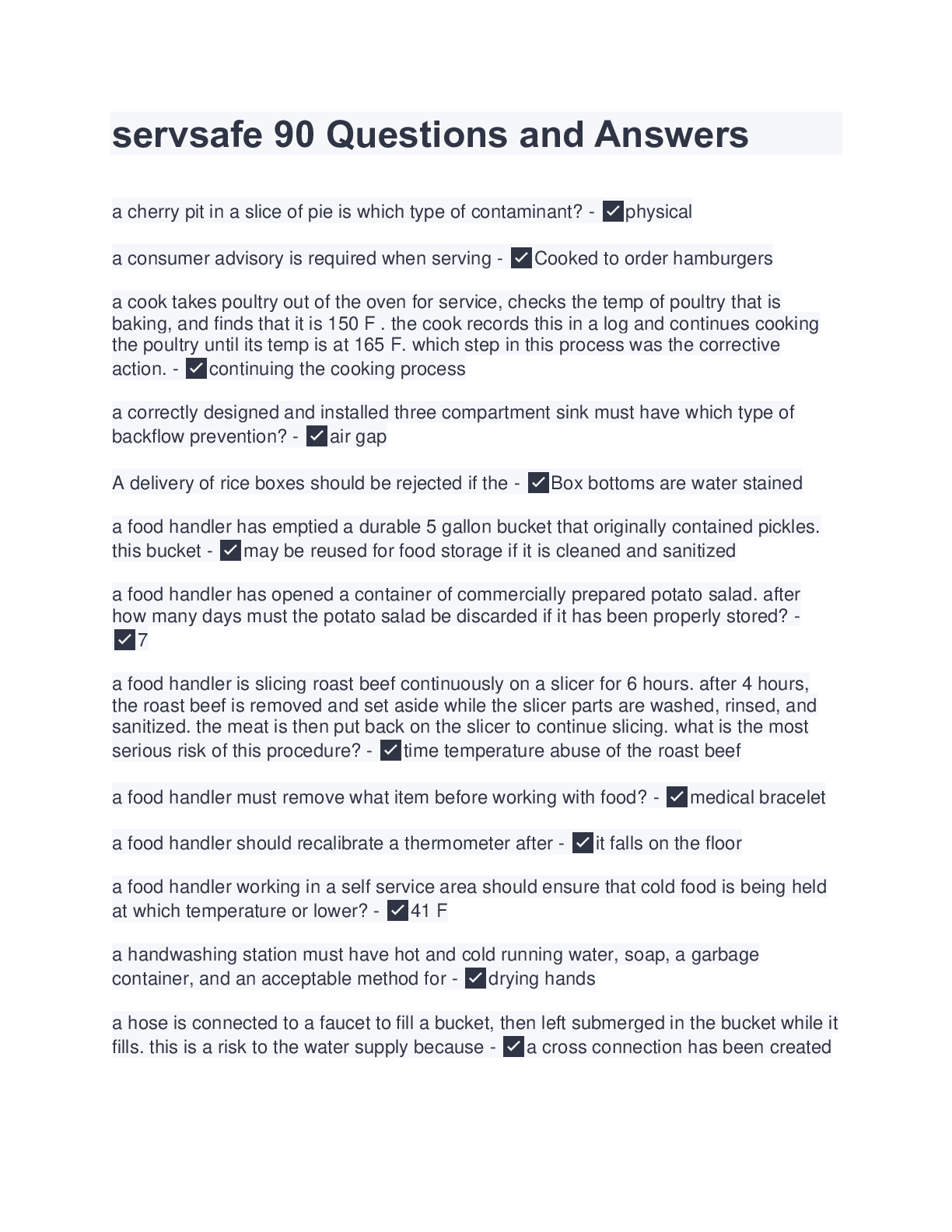
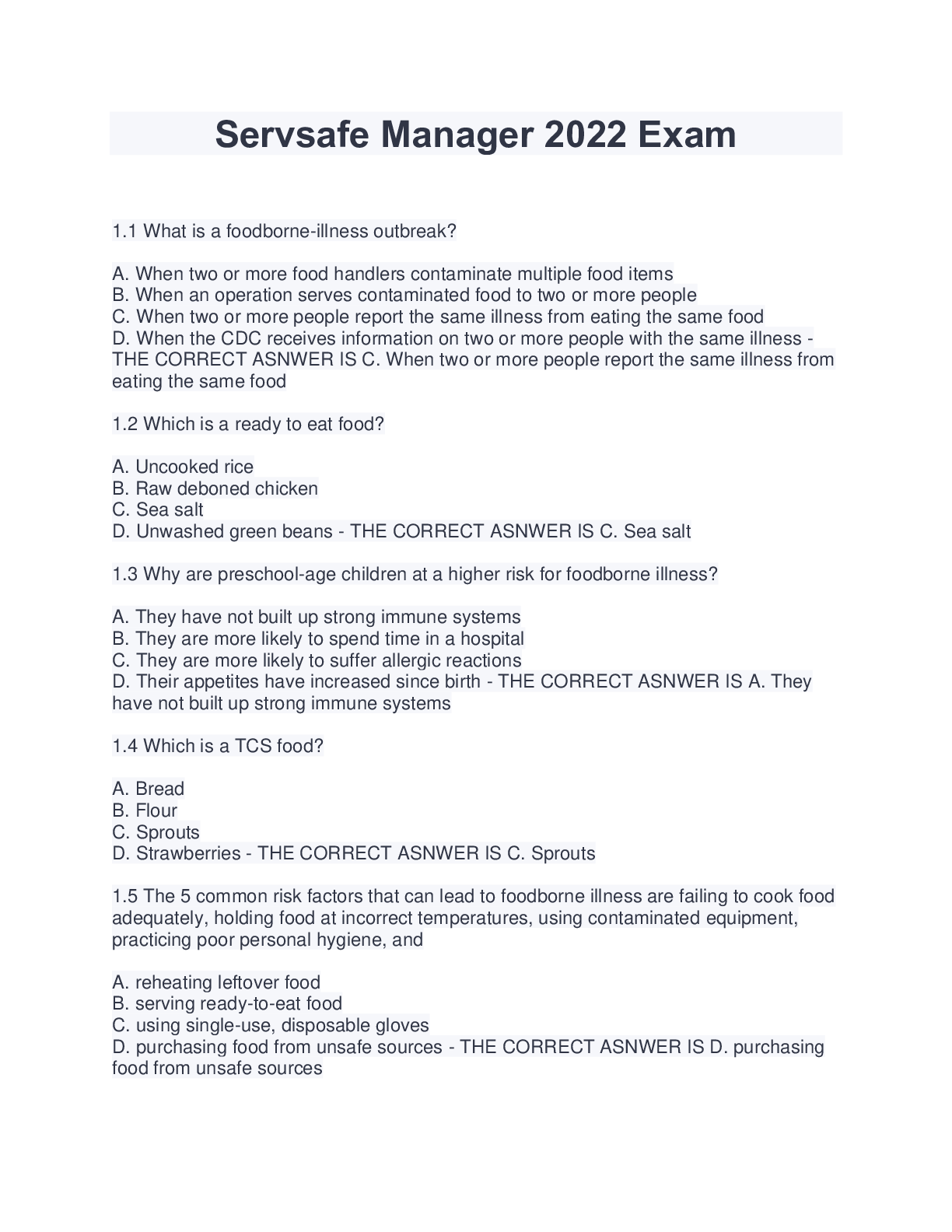

.png)


